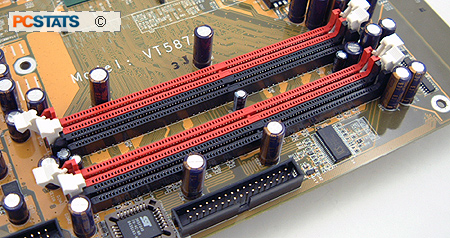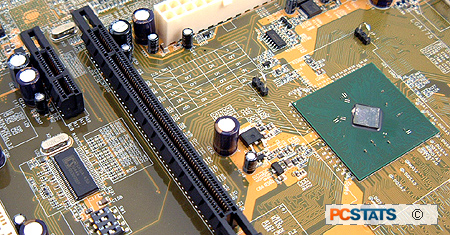As mentioned
earlier, the new VIA PT894 supports Socket 775 Pentium 4 processors that
run on 533MHz, 800MHz and 1066MHz front side bus speeds. The chipset works with both DDR (up
to DDR400) as well as DDR2 (up to DDR2 667) memory, of course you cannot run
both memory standards at the same time. The total amount of memory that can be
installed in the PT894 is an amazing 16GB RAM. On Intel's front,
the 925X/XE/915P chipsets will support just 4GB RAM. The board PCstats
tested came equipped with DDR
memory slots only.

The VIA PT894 chipset supports a total of 18 PCI Express
lanes; a PCI Express x16 lane for the
videocard and two PCI Express x1 lanes that connect directly to the PT894
chipset. There are two more 1x PCI Express lanes available but those
run through the Southbridge first. The southbridge is connected to the Northbridge through VIA's
Ultra V-Link which runs at 1 GHz through a 16-bit pipeline, and
has a total 1066MB/s of bandwidth availible.

VIA is also particularly proud of its new VIA VT8251
Southbridge, which ironically is not used on the PT894 reference motherboard. Like
the nForce4 MCP variants, the new VT8251 supports the new Serial ATA II standard
and can be used with up to four devices. With Serial ATA you can also run
RAID, specifically modes 0, 1, 0+1 and 5 or if you don't want to use RAID the
controller works with JBOD as well. The VIA VT8251 also has an integrated 10/100
MAC and if a manufacturer chooses to integrate a Gigabit NIC, they can do so
through a special bus that runs through the Southbridge, not PCI bus.

One very neat feature of the new VT8251
Southbridge is VIA's Port Multiplier feature. VIA states that if the Serial ATA
II on the motherboard is connected to a "Port Multiplier" type device, the
motherboard can actually handle up to 60 SATA HDDs! Of course these
port multipliers are not available on the market yet and VIA was quite vague on
how exactly this is implemented.
Any luck
overclocking?
In the past,
VIA chipsets have generally overclocked quite well. Unfortunately we didn't have much luck
with the PT880 reference board we tested last year, nor did we have luck overclocking the
few KT600, K8T800 or K8T800 Pro motherboards we've tested since then either. With
that in mind we didn't have much expectations from the PT894 chipset.

Starting at 200 MHz FSB I slowly raised
the clock speed of the motherboard a few MHz at a time. Things were pretty
uneventful till we hit around 214 MHz, anything past that the system would
sometimes not POST, other times it would simply BSOD during bootup. Raising
voltages didn't help, the motherboard only allowed for memory and CPU voltage,
both of which have been tested higher already.
I guess our results are not all that surprising, after all this is
a reference board. I would expect retail motherboards to overclock higher but
we'll have to wait and see before we know for certain.
